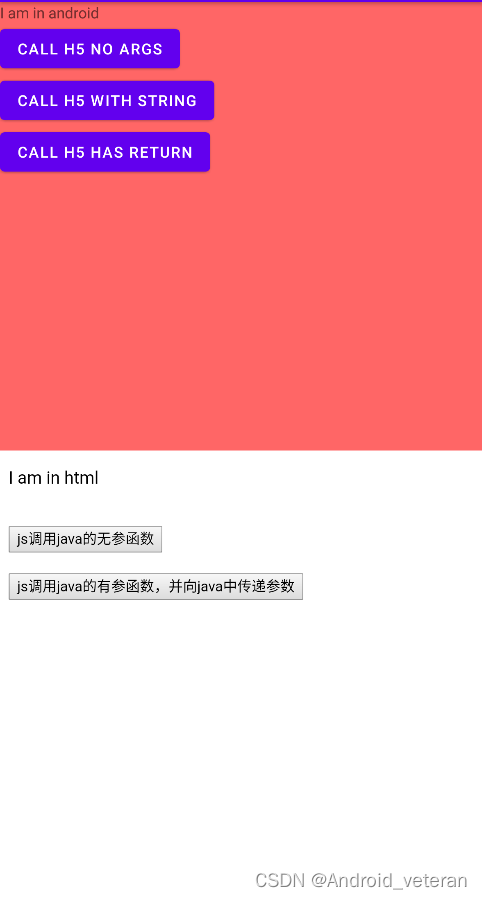现在混合式开发是大趋势,H5不断蚕食移动互联网的份额,有的公司甚至只用H5就搞了一个APP,我们搞Android的不说会点H5,至少要懂怎么和H5(和JavaScript)交互,费话不多说。
一、先看效果:
二、此效果图实现了以下4个功能:
- Java调用JS中的无参函数(无返回值);
- Java调用JS中的有参函数(无返回值),参数是从Java中传入的;
- Java调用JS中的无参函数(有返回值,有返回值,有返回值);
- JS调用Java的无参函数;
- JS调用Java中的有参函数,参数是从JS中传入的;
三、说几个重点的地方:
1、调用本地html的方法(html放在assets文件夹中,当然实战中会是一个网址,html一般是H5开发人员来写)
//打开从本地assets中的html文件
mWebView.loadUrl("file:///android_asset/androidAndJs.html");
2、在Android中声明一个接口名字,供JS调用( addJavascriptInterface()的第二个参数 )
//提供给js的接口名称
mWebView.addJavascriptInterface(mContext, "android");
3、调用WebView的addJavascriptInterface(),需要在Activity的onCreate()方法上加上注解:@SuppressLint(“JavascriptInterface”)
@SuppressLint("JavascriptInterface")
@Override
public void onCreate(Bundle savedInstanceState) {
//省略
}
4、供JS调用的方法要加上注解:@JavascriptInterface
//供JS调用的方法
@JavascriptInterface
public void jsCallJava(){
runOnUiThread(new Runnable() {
@Override
public void run() {
Toast.makeText(mContext, "js调用java的代码", Toast.LENGTH_SHORT).show();
}
});
}
5、Java调用JS代码
__5.1 调用JS无参函数
mWebView.loadUrl("javascript:javaCallJs()");
__5.2 如果要传参数,字符串用单引号包裹!
mWebView.loadUrl("javascript:javaCallJsWithArgs('我是从java过来的参数')");
__5.3 调用JS无参函数(有返回值,有返回值,有返回值)
mWebView.evaluateJavascript("javaCallJsHasReturn()", new ValueCallback<String>() {
@Override
public void onReceiveValue(String value) {
Toast.makeText(mContext, "js返回的结果是=" + value, Toast.LENGTH_SHORT).show();
}
6、不要忘记网络权限
<uses-permission android:name="android.permission.INTERNET" />
四、接下来是完整代码:
布局文件:
<?xml version="1.0" encoding="utf-8"?>
<LinearLayout
xmlns:android="http://schemas.android.com/apk/res/android"
android:layout_width="match_parent"
android:layout_height="match_parent"
android:background="@color/colorPrimary"
android:orientation="vertical">
<LinearLayout
android:layout_width="match_parent"
android:layout_height="0dp"
android:layout_weight="1"
android:background="#99FF0000"
android:orientation="vertical">
<TextView
android:layout_width="wrap_content"
android:layout_height="wrap_content"
android:text="I am in android" />
<Button
android:id="@+id/btn_no_args"
android:layout_width="0dp"
android:layout_height="wrap_content"
android:layout_margin="5dp"
android:layout_weight="1"
android:background="@color/colorAccent"
android:text="调用js的函数"/>
<Button
android:id="@+id/btn_with_args"
android:layout_width="0dp"
android:layout_height="wrap_content"
android:layout_margin="5dp"
android:layout_weight="1"
android:background="@color/colorAccent"
android:text="向js传参数"/>
<Button
android:id="@+id/btn_has_return"
android:layout_width="0dp"
android:layout_height="wrap_content"
android:layout_margin="5dp"
android:layout_weight="1"
android:background="@color/colorAccent"
android:text="向js传参数,有返回值"/>
</LinearLayout>
<WebView
android:id="@+id/webview"
android:layout_width="match_parent"
android:layout_height="0dp"
android:layout_weight="1"/>
</LinearLayout>
MainActivity代码:
package com.clipperl.androidjsdemo2;
import android.annotation.SuppressLint;
import android.content.Context;
import android.os.Bundle;
import android.support.v7.app.AppCompatActivity;
import android.view.View;
import android.webkit.JavascriptInterface;
import android.webkit.WebView;
import android.widget.Button;
import android.widget.TextView;
import android.widget.Toast;
public class MainActivity extends AppCompatActivity {
private Context mContext = this;
private WebView mWebView;
private TextView mTvShow;
private Button mBtnNoArgs, mBtnWithArgs, mBtnHasReturn;
@SuppressLint("JavascriptInterface")
@Override
public void onCreate(Bundle savedInstanceState) {
super.onCreate(savedInstanceState);
setContentView(R.layout.activity_main);
initView();
//支持javascript
mWebView.getSettings().setJavaScriptEnabled(true);
//打开从本地assets中的html文件
mWebView.loadUrl("file:///android_asset/androidAndJs.html");
//提供给js的接口名称
mWebView.addJavascriptInterface(mContext, "android");
}
private void initView() {
mWebView = (WebView) findViewById(R.id.webview);
mTvShow = (TextView) findViewById(R.id.tv_show);
mBtnNoArgs = (Button) findViewById(R.id.btn_no_args);
mBtnWithArgs = (Button) findViewById(R.id.btn_with_args);
mBtnHasReturn= (Button) findViewById(R.id.btn_has_return);
mBtnNoArgs.setOnClickListener(new View.OnClickListener() {
@Override
public void onClick(View v) {
mWebView.loadUrl("javascript:javaCallJs()");
}
});
mBtnWithArgs.setOnClickListener(new View.OnClickListener() {
@Override
public void onClick(View v) {
mWebView.loadUrl("javascript:javaCallJsWithArgs('我是从java过来的参数')");
}
});
mBtnHasReturn.setOnClickListener(new View.OnClickListener() {
@Override
public void onClick(View v) {
mWebView.evaluateJavascript("javaCallJsHasReturn()", new ValueCallback<String>() {
@Override
public void onReceiveValue(String value) {
Toast.makeText(mContext, "js返回的结果是=" + value, Toast.LENGTH_SHORT).show();
}
}
});
}
//供JS调用的方法
@JavascriptInterface
public void jsCallJava(){
runOnUiThread(new Runnable() {
@Override
public void run() {
Toast.makeText(mContext, "js调用java的代码", Toast.LENGTH_SHORT).show();
}
});
}
//供JS调用的方法
@JavascriptInterface
public void jsCallJavaWithArgs(final String args){
runOnUiThread(new Runnable() {
@Override
public void run() {
Toast.makeText(mContext, "js调用了java的代码,并传入以下参数:\n" + args, Toast.LENGTH_SHORT).show();
}
});
}
}
最后是html文件:
<!DOCTYPE html>
<html>
<head>
<meta charset="UTF-8">
<title></title>
<script type="text/javascript">
function javaCallJs(){
document.getElementById("content").innerHTML = "java刚刚调用了js的无参函数javaCallJs";
}
function javaCallJsWithArgs(args){
document.getElementById("content").innerHTML = "java调用了js的有参函数,传入的参数为:<br>" + args;
}
function javaCallJsHasReturn(){
return 23
}
</script>
</head>
<body>
html网页<br />
<input type="button" value="js调用java的无参函数" onclick="window.android.jsCallJava()" />
<input type="button" value="js调用java的有参函数,并向java中传递参数" onclick="window.android.jsCallJavaWithArgs('我是从js中来的参数')"/>
<div id="content"></div>
</body>
</html>
